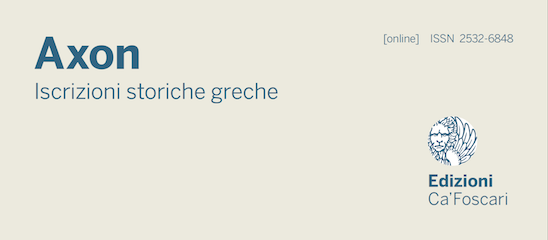Cataldi, Symbolai = Cataldi, S. (a cura di) (1983). Symbolai e relazioni tra le città greche nel V secolo a.C. Introduzione, edizione critica, traduzione, commento e indici . Pisa (Relazioni interstatali nel mondo antico. Fonti e studi 4).
Cataldi, Symbolai = Cataldi, S. (a cura di) (1983). Symbolai e relazioni tra le città greche nel V secolo a.C. Introduzione, edizione critica, traduzione, commento e indici . Pisa (Relazioni interstatali nel mondo antico. Fonti e studi 4).
HGIÜ II = Brodersen, K.; Günther, W.; Schmitt, H.H. (a cura di) (1996). Historische Griechische Inschriften in Übersetzung, vol. II: Spätklassik und früher Hellenismus (400-250 v. Chr.). Darmstadt.
HGIÜ II = Brodersen, K.; Günther, W.; Schmitt, H.H. (a cura di) (1996). Historische Griechische Inschriften in Übersetzung, vol. II: Spätklassik und früher Hellenismus (400-250 v. Chr.). Darmstadt.
IG II.1 = Koehler, U.; Kirchhoff, A. (edd.) (1877). Inscriptiones Graecae. Inscriptiones Atticae aetatis quae est inter Euclidis annum et Augusti tempora Part I. Berlin (nos. 1-641).
IG II.1 = Koehler, U.; Kirchhoff, A. (edd.) (1877). Inscriptiones Graecae. Inscriptiones Atticae aetatis quae est inter Euclidis annum et Augusti tempora Part I. Berlin (nos. 1-641).
IG II².1.2 = Kirchner, J. (ed.) (1916). Inscriptiones Graecae. Voll. II et III, Inscriptiones Atticae Euclidis anno posteriores. Part 1, fasc. 2, Decrees and Sacred Laws. Ed altera. Berlin (nos. 1-1369 in fasc. 1 e 2).
IG II².1.2 = Kirchner, J. (ed.) (1916). Inscriptiones Graecae. Voll. II et III, Inscriptiones Atticae Euclidis anno posteriores. Part 1, fasc. 2, Decrees and Sacred Laws. Ed altera. Berlin (nos. 1-1369 in fasc. 1 e 2).
Lawton, ADR = Lawton, C.L. (a cura di) (1995). Attic Document Reliefs. Art and Politics in Ancient Athens. Oxford.
Lawton, ADR = Lawton, C.L. (a cura di) (1995). Attic Document Reliefs. Art and Politics in Ancient Athens. Oxford.
Pouilloux, Choix = Pouilloux, J. (a cura di) (1960). Choix d'inscriptions grecques. Textes, traductions et notes. Paris (Bibl. de la Fac. des Lettres de Lyon, iv). [Choix d'inscriptions grecques². Sous la direction de J. Pouilloux. Textes, traductions et notes publiés sous la direction de J. Pouilloux, avec un supplément bibliographique par G. Rougemont et D. Rousset].
Pouilloux, Choix = Pouilloux, J. (a cura di) (1960). Choix d'inscriptions grecques. Textes, traductions et notes. Paris (Bibl. de la Fac. des Lettres de Lyon, iv). [Choix d'inscriptions grecques². Sous la direction de J. Pouilloux. Textes, traductions et notes publiés sous la direction de J. Pouilloux, avec un supplément bibliographique par G. Rougemont et D. Rousset].
Rhodes - Osborne, GHI = Rhodes, P.J.; Osborne, R (eds.) (2003). Greek Historical Inscriptions, 404-323 B.C. Oxford.
Rhodes - Osborne, GHI = Rhodes, P.J.; Osborne, R (eds.) (2003). Greek Historical Inscriptions, 404-323 B.C. Oxford.
Rhodes, Boule = Rhodes, P.J. (ed.) (1972). The Athenian Boule. Oxford.
Rhodes, Boule = Rhodes, P.J. (ed.) (1972). The Athenian Boule. Oxford.
Staatsverträge II = Bengtson, H. (Hrsg) (1962). Die Staatsverträge des Altertums, II. München.
Staatsverträge II = Bengtson, H. (Hrsg) (1962). Die Staatsverträge des Altertums, II. München.
Syll. I = Dittenberger, W. (a cura di) (1883). Sylloge Inscriptionum Graecarum, 1st ed. Vol. I. Ausg. Leipzig.
Syll. I = Dittenberger, W. (a cura di) (1883). Sylloge Inscriptionum Graecarum, 1st ed. Vol. I. Ausg. Leipzig.
Syll.³ I = Dittenberger, W. (ed.) (1915-1924). Sylloge Inscriptionum Graecarum, Bd. I, 3. Ausg. Leipzig.
Syll.³ I = Dittenberger, W. (ed.) (1915-1924). Sylloge Inscriptionum Graecarum, Bd. I, 3. Ausg. Leipzig.
Tod, GHI II = Tod, M.N. (a cura di) (1948). A Selection of Greek Historical Inscriptions II. From 403 to 323 B.C. Oxford.
Tod, GHI II = Tod, M.N. (a cura di) (1948). A Selection of Greek Historical Inscriptions II. From 403 to 323 B.C. Oxford.
Walter, Akropolismuseum = Walter, O. (a cura di) (1923). Beschreibung der Reliefs im kleinen Akropolismuseum in Athen. Wien.
Walter, Akropolismuseum = Walter, O. (a cura di) (1923). Beschreibung der Reliefs im kleinen Akropolismuseum in Athen. Wien.
Accame, S. (a cura di) (1941). La lega ateniese del sec. IV a.C. Roma.
Accame, S. (a cura di) (1941). La lega ateniese del sec. IV a.C. Roma.
Badian, E. (1987). «The Peace of Callias». JHS, 107, 1-39.
Badian, E. (1987). «The Peace of Callias». JHS, 107, 1-39.
Badian, E. (1991). «The King’s Peace». Flower, M. A.; Cawkwell, G.L.; Toher, M. (a cura di), Georgica: Greek Studies in Honour of George Cawkwell, Bulletin Supplement 58. London, 25-48.
Badian, E. (1991). «The King’s Peace». Flower, M. A.; Cawkwell, G.L.; Toher, M. (a cura di), Georgica: Greek Studies in Honour of George Cawkwell, Bulletin Supplement 58. London, 25-48.
Badian, E. (1995). «The Ghost of Empire. Reflections on Athenian Foreign Policy in the Fourth Century B.C». Eder, W. (Hrsg), Die athenische Demokratie im 4. Jahrhundert v. Chr.: Vollendung oder Verfall einer Verfassungsform? . Stuttgart., 79-106.
Badian, E. (1995). «The Ghost of Empire. Reflections on Athenian Foreign Policy in the Fourth Century B.C». Eder, W. (Hrsg), Die athenische Demokratie im 4. Jahrhundert v. Chr.: Vollendung oder Verfall einer Verfassungsform? . Stuttgart., 79-106.
Bartoletti, V. (a cura di) (1959). Hellenica Oxyrhynchia. Ausg. Leipzig.
Bartoletti, V. (a cura di) (1959). Hellenica Oxyrhynchia. Ausg. Leipzig.
Bertrand, J.-M. (éd.) (1992). Inscriptions historiques grecques, trad. et commentées par Jean-Marie Bertrand. Paris.
Bertrand, J.-M. (éd.) (1992). Inscriptions historiques grecques, trad. et commentées par Jean-Marie Bertrand. Paris.
Binneboeßel, R. (a cura di) (1932). Studien zu den attischen Urkundenreliefs des 5. und 4. Jahrhunderts v.Chr. Leipzig Kaldenkirchen Dissertation.
Binneboeßel, R. (a cura di) (1932). Studien zu den attischen Urkundenreliefs des 5. und 4. Jahrhunderts v.Chr. Leipzig Kaldenkirchen Dissertation.
Cargill, J. (a cura di) (1981). The Second Athenian League: Empire or Free Alliance?. Berkeley; Los Angeles; London.
Cargill, J. (a cura di) (1981). The Second Athenian League: Empire or Free Alliance?. Berkeley; Los Angeles; London.
Costa, A. (1974). «Evagoras I and the Persians, CA. 411 to 391 B.C». Historia, 23, 40-56.
Costa, A. (1974). «Evagoras I and the Persians, CA. 411 to 391 B.C». Historia, 23, 40-56.
Dušanić, S. (1999). «Isocrates, the Chian Intellectuals, and the Political Context of the Euthydemus». JHS, 119, 1-16. Cfr. SEG XLIX 92
Dušanić, S. (1999). «Isocrates, the Chian Intellectuals, and the Political Context of the Euthydemus». JHS, 119, 1-16. Cfr. SEG XLIX 92
Dušanić, S. (2000). «The Attic-Chian Alliance (IG II2 34) and the ‘Troubles in Greece’ of the Late 380’s BC». ZPE, 133, 21-30. Cfr. SEG L 92
Dušanić, S. (2000). «The Attic-Chian Alliance (IG II2 34) and the ‘Troubles in Greece’ of the Late 380’s BC». ZPE, 133, 21-30. Cfr. SEG L 92
Harding, P. (ed.) (1985). Translated Documents of Greece and Rome, vol. II: From the End of the Peloponnesian War to the Battle of Ipsus. Cambridge.
Harding, P. (ed.) (1985). Translated Documents of Greece and Rome, vol. II: From the End of the Peloponnesian War to the Battle of Ipsus. Cambridge.
Hiller, F. (a cura di) (1971). Formgeschichtliche Untersuchungen zur griechischen Statue des späten 5. Jahthunderts v.Chr. Mainz am Rhein.
Hiller, F. (a cura di) (1971). Formgeschichtliche Untersuchungen zur griechischen Statue des späten 5. Jahthunderts v.Chr. Mainz am Rhein.
Hornblower, S. (a cura di) (2011). The Greek World 479-323 BC. London.
Hornblower, S. (a cura di) (2011). The Greek World 479-323 BC. London.
Karavites, P. (1982). «Eleutheria and Autonomia in Fifth Century Interstate Relations». RIDA, 29, 145-162.
Karavites, P. (1982). «Eleutheria and Autonomia in Fifth Century Interstate Relations». RIDA, 29, 145-162.
Koehler, U. (1877). «Attische Psephismen aus der ersten Hälfte des vierten Jahrhunderts». MDAI(A), 2, 210-12.
Koehler, U. (1877). «Attische Psephismen aus der ersten Hälfte des vierten Jahrhunderts». MDAI(A), 2, 210-12.
Koumanoudes, S.A. (1876/1877). «nr. 4». Αθήναιον, 5, 520-521.
Koumanoudes, S.A. (1876/1877). «nr. 4». Αθήναιον, 5, 520-521.
Lévy, E. (1983). «Autonomia et Éleutheria au Ve siecle». RPh, 249-270.
Lévy, E. (1983). «Autonomia et Éleutheria au Ve siecle». RPh, 249-270.
McKechnie, P.J.; Kern, S.J. (a cura di) (1988). Hellenica Oxyrhynchia. Warminster.
McKechnie, P.J.; Kern, S.J. (a cura di) (1988). Hellenica Oxyrhynchia. Warminster.
Mitchell, L.G. (a cura di) (1997). Greeks Bearing Gifts. Cambridge.
Mitchell, L.G. (a cura di) (1997). Greeks Bearing Gifts. Cambridge.
Mosley, D.J. (1961). «Who ‘Signed’ Treaties in Ancient Greece?». PCPhS, 7, 59-63.
Mosley, D.J. (1961). «Who ‘Signed’ Treaties in Ancient Greece?». PCPhS, 7, 59-63.
Occhipinti, E. (2010). «Political Conflicts in Chios Between the End of the 5th and the First Half of the 4th Century B.C.». AHB, 24, 23-43.
Occhipinti, E. (2010). «Political Conflicts in Chios Between the End of the 5th and the First Half of the 4th Century B.C.». AHB, 24, 23-43.
Perlman, S. (1963). «The Politicians in the Athenian Democracy of the fourth Century B.C». Athenaeum, 327-335.
Perlman, S. (1963). «The Politicians in the Athenian Democracy of the fourth Century B.C». Athenaeum, 327-335.
Rung, E. (2008). «War, Peace and Diplomacy in Graeco-Persian Relations from the Sixth to the Fourth Century BC». De Souza, P.; France, J. (eds.), War and Peace in Ancient Medieval History. Cambridge, 28-50.
Rung, E. (2008). «War, Peace and Diplomacy in Graeco-Persian Relations from the Sixth to the Fourth Century BC». De Souza, P.; France, J. (eds.), War and Peace in Ancient Medieval History. Cambridge, 28-50.
Seager, R.J. (1994). «The King’s Peace and the Second Athenian Confederacy». Lewis, D.M.; Boardman, J.; Hornblower, S.; Ostwald, M. (eds.), CAH VI2. Cambridge, 156-186.
Seager, R.J. (1994). «The King’s Peace and the Second Athenian Confederacy». Lewis, D.M.; Boardman, J.; Hornblower, S.; Ostwald, M. (eds.), CAH VI2. Cambridge, 156-186.
Shrimpton, G.S. (a cura di) (1991). Theopompus the Historian. Montreal-Kingston.
Shrimpton, G.S. (a cura di) (1991). Theopompus the Historian. Montreal-Kingston.
Smith, A.C. (a cura di) (2011). Polis and Personification in Classical Athenian Art. Leiden; Boston.
Smith, A.C. (a cura di) (2011). Polis and Personification in Classical Athenian Art. Leiden; Boston.
Süsserott , H.K. (a cura di) (1938). Griechische Plastik des 4. Jahrhunderts vor Christus: Untersuchungen zur Zeitbestimmung. Frankfurt auf Main.
Süsserott , H.K. (a cura di) (1938). Griechische Plastik des 4. Jahrhunderts vor Christus: Untersuchungen zur Zeitbestimmung. Frankfurt auf Main.
Tuplin, C. (a cura di) (1993). The Failings of Empire. A reading of Xenophon Hellenica 2.3-.11-7.5.27. Stuttgart.
Tuplin, C. (a cura di) (1993). The Failings of Empire. A reading of Xenophon Hellenica 2.3-.11-7.5.27. Stuttgart.
Whitehead, D. (1990). «Abbreviated Athenian Demotics». ZPE, 81, 101-162.
Whitehead, D. (1990). «Abbreviated Athenian Demotics». ZPE, 81, 101-162.
Wilhelm, A. (1903). «Besprechung von Dittenberger, Syll. I[2]». GGA, 10, 782.
Wilhelm, A. (1903). «Besprechung von Dittenberger, Syll. I[2]». GGA, 10, 782.
Wilhelm, A. (1903). «Besprechung von Dittenberger, Syll. I[2]». GGA, 10, 782.
Wilhelm, A. (1903). «Besprechung von Dittenberger, Syll. I[2]». GGA, 10, 782.
Wilhelm, A. (1903). «Besprechung von Dittenberger, Syll. I[2]». GGA, 10, 782.
Wilhelm, A. (1903). «Besprechung von Dittenberger, Syll. I[2]». GGA, 10, 782.
Dušanić, S. (1999). «Isocrates, the Chian Intellectuals, and the Political Context of the Euthydemus». JHS, 119, 1-16. Cfr. SEG XLIX 92
Syll. I = Dittenberger, W. (a cura di) (1883). Sylloge Inscriptionum Graecarum, 1st ed. Vol. I. Ausg. Leipzig.
Dušanić, S. (1999). «Isocrates, the Chian Intellectuals, and the Political Context of the Euthydemus». JHS, 119, 1-16. Cfr. SEG XLIX 92
| 
















 theta.
theta.